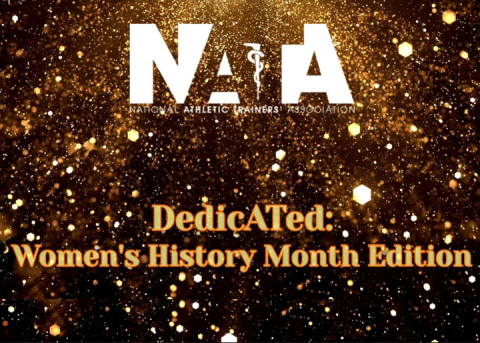
By Kathleen Searles, MS, CSSD, RDN, Jim Seeger, MEd, RD, ATC, and Shane Mikesky, MS, CSCS, The Sports, Cardiovascular and Wellness Nutrition Group of the Academy of Nutrition and Dietetics
The August/September NATA News, available online now, features the article “Marching to Wellness,” which explores the role athletic trainers can play in promoting the health and well-being of marching artists.
An important component of health and wellness is nutrition. Marching artists face nutrition concerns that athletic trainers should be aware of and know how to address.
Marching artists may be at an increased risk of injury, heat illnesses and other health problems because of nutritional shortfalls and excesses. Sharma et al found that university marching band members reported fewer than recommended servings of grains, fruits and vegetables as well as water, and that most were not ready to make dietary changes. They also found that 45 percent of the participants were overweight or obese, increasing risk of cardiovascular disease and injury.1,2
Woolf et al studied 323 marching artists participating in Drum Corps International (71 percent), Winter Guard International (26 percent), university marching band (30 percent) or high school marching band (20 percent). (Note that subjects may participate at multiple levels.) They looked at diet quality based on the Healthy Eating Index (HEI), which assesses diet quality compared to the U.S. Dietary Guidelines. They found that the average HEI score was in the “fair” category, with only 1 percent of participants scoring in the “good” range. Only one participant met the guideline for whole grain intake. In general, participants consumed excess saturated fat, sodium and empty calories.1
Certified athletic trainers should support general healthful eating, including promoting variety, moderate portion sizes, ample fruits, vegetables and whole grains, and minimizing foods and beverages with added sugars.2 Encourage water with meals, as many student athletes do not maintain good baseline hydration.3 Nutrition advice should include avoiding excess alcohol intake as this can impair performance and increase risk of heat-related illness. Sharma et al found that more than 10 percent of study participants consumed five or more servings of alcohol weekly.2
A light snack or meal is suggested about 30 minutes prior to practice or performance. At this time, food should be lower in fiber and fat to prevent digestive upset. After activity, a recovery snack or meal containing protein and carbohydrates is suggested. In general, band members should consider their pre- and post-activity intake as part of their total daily intake rather than as extra food, given the prevalence of overweight and obesity among marching artists.1,2,4
Like other athletes, marching artists may struggle with juggling practice times, performances and travel with eating healthfully. Meals and snacks should contribute to overall diet quality and include nutrient-dense foods. A planned nutrition strategy has been associated with improved performance and recovery in athletes, so marching artists should plan ahead to have food available for pre- and post-activity. Options for nonperishable, mini-meals include nut butter sandwiches, tuna or chicken salad kits or boxes of whole grain cereals with shelf-stable milk. Round out a mini-meal with fresh or dried fruit or a fruit or applesauce cup. Choices for pre- and post-activity snacks and traveling could include whole grain crackers, nuts, trail mix, granola, shelf-stable chocolate milk or 100 percent fruit juice. If a cooler is available, snacks such as raw veggies, yogurt, cheese sticks and hummus cups are convenient.1,2,4 Some schools have added healthier choices, such as chicken sandwiches, soft pretzels, fruit and granola, to their concessions menu. These could also be good options for band members who like to purchase food at a game.5
References
1. McConnell C, McPherson A, Woolf K. Competition level not associated with diet quality in marching artists. J Sport Nutr Exerc Metab. 2018 Jan1; 28(1):66-74.
2. Sharma SV, Bush JA, Lorino AJ, Knoblauch M, et al. Diet and cardiovascular Risk in University Marching Band, Dance Team and Cheer Squad Members: a cross-sectional study. J Int Soc Sport Nutr. 2008, 5:9.
3. McDermott BP, Anderson SA, Armstrong LE, et al. National Athletic Trainers’ Association Position Statement: Fluid Replacement for the Physically Active. J Athl Train. 2017;52(9):877–895.
4. Burden M. Nutrition for Marching Arts: Fueling Athletes and the Arts. Athletes in the Arts Fact Sheet. Sports, Cardiovascular and Wellness Nutrition, Academy of Nutrition and Dietetics. 2020.
5. Laroche HH, Ford C, Hansen K, et al. Concession stand makeovers: a pilot study of offering healthy food at high school concession stands. J Public Health. 2014; 37(1):116-124.





